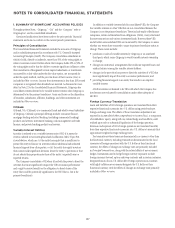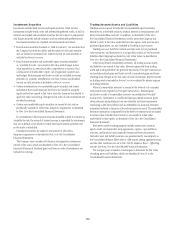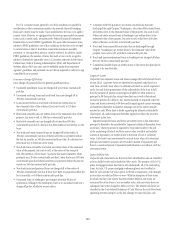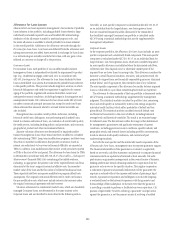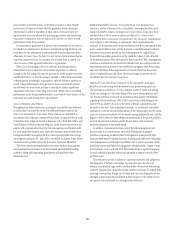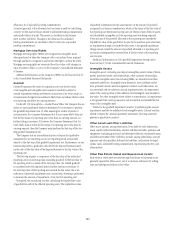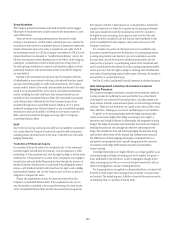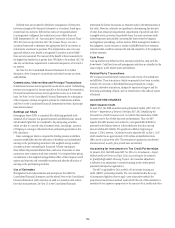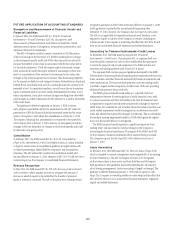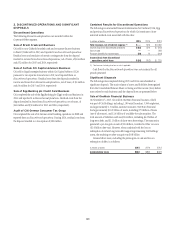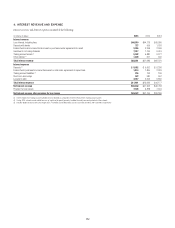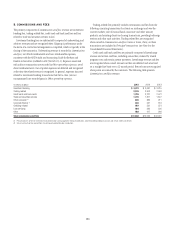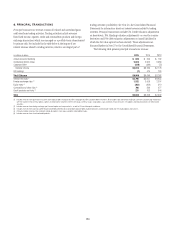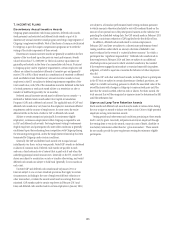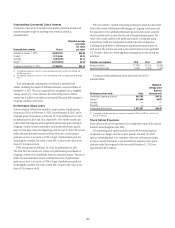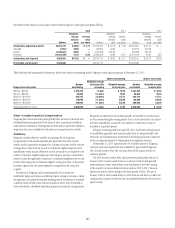Citibank 2015 Annual Report Download - page 165
Download and view the complete annual report
Please find page 165 of the 2015 Citibank annual report below. You can navigate through the pages in the report by either clicking on the pages listed below, or by using the keyword search tool below to find specific information within the annual report.147
tax benefits received. Citi qualifies to elect the proportional amortization
method under the ASU for its entire LIHTC portfolio. These investments were
previously accounted for under the equity method, which resulted in losses
(due to amortization of the investment) being recognized in Other revenue
and tax credits and benefits being recognized in the Income tax expense
line. In contrast, the proportional amortization method combines the
amortization of the investment and receipt of the tax credits/benefits into one
line, Income tax expense.
Citi adopted ASU 2014-01 in the first quarter of 2015. The adoption of
this ASU was applied retrospectively and cumulatively reduced Retained
earnings by approximately $349 million, Other assets by approximately
$178 million, and deferred tax assets by approximately $171 million.
Accounting for Repurchase-to-Maturity Transactions
In June 2014, the FASB issued ASU No. 2014-11, Transfers and Servicing
(Topic 860): Repurchase-to-Maturity Transactions, Repurchase
Financings, and Disclosures. The ASU changes the accounting for
repurchase-to-maturity transactions and linked repurchase financings to
secured borrowing accounting, which is consistent with the accounting
for other repurchase agreements. The ASU also requires disclosures about
transfers accounted for as sales in transactions that are economically
similar to repurchase agreements (see Note 23 to the Consolidated Financial
Statements) and about the types of collateral pledged in repurchase
agreements and similar transactions accounted for as secured borrowings
(see Note 11 to the Consolidated Financial Statements). The ASU’s provisions
became effective for Citi in the first quarter of 2015, with the exception of the
collateral disclosures which became effective in the second quarter of 2015.
The effect of adopting the ASU is required to be reflected as a cumulative
effect adjustment to retained earnings as of the beginning of the period
of adoption. Adoption of the ASU did not have a material effect on the
Company’s financial statements.
Disclosures for Investments in Certain Entities That
Calculate Net Asset Value (NAV) per Share
In May 2015, the FASB issued ASU No. 2015-07, Fair Value Measurement
(Topic 820): Disclosures for Investments in Certain Entities That
Calculate Net Asset Value per Share (or Its Equivalent), which is intended
to reduce diversity in practice related to the categorization of investments
measured at NAV within the fair value hierarchy. The ASU removes the
current requirement to categorize investments for which fair value is
measured using the NAV per share practical expedient within the fair
value hierarchy. Citi elected to early adopt the ASU in the second quarter
of 2015. The adoption of the ASU was applied retrospectively and reduced
Level 3 assets by $1.0 billion and $1.1 billion as of December 31, 2015 and
December 31, 2014, respectively.
Discontinued Operations and Significant Disposals
The FASB issued ASU No. 2014-08, Presentation of Financial Statements
(Topic 810) and Property, Plant, and Equipment (Topic 360), Reporting
Discontinued Operations and Disclosures of Disposals of Components of
an Entity (ASU 2014-08) in April 2014. ASU 2014-08 changes the criteria
for reporting discontinued operations while enhancing disclosures. Under
the ASU, only disposals representing a strategic shift having a major effect
on an entity’s operations and financial results, such as a disposal of a
major geographic area, a major line of business or a major equity method
investment, may be presented as discontinued operations. Additionally, the
ASU requires expanded disclosures about discontinued operations that will
provide more information about the assets, liabilities, income and expenses
of discontinued operations.
The Company early-adopted the ASU in the second quarter of 2014 on
a prospective basis for all disposals (or classifications as held-for-sale) of
components of an entity that occurred on or after April 1, 2014. As a result
of the adoption of the ASU, fewer disposals will now qualify for reporting
as discontinued operations; however, disclosure of the pretax income
attributable to a disposal of a significant part of an organization that does
not qualify for discontinued operations reporting is required. The impact of
adopting the ASU was not material.
Classification of Certain Government-Guaranteed
Mortgage Loans upon Foreclosure
In August 2014, the FASB issued ASU No. 2014-14, Receivables-Troubled
Debt Restructuring by Creditors (Subtopic 310-40): Classification of
Certain Government-Guaranteed Mortgage Loans upon Foreclosure,
which requires that a mortgage loan be derecognized and a separate other
receivable be recognized upon foreclosure if the following conditions are met:
(i) the loan has a government guarantee that is not separable from the loan
before foreclosure; (ii) at the time of foreclosure, the creditor has the intent
to convey the real estate property to the guarantor and make a claim on the
guarantee, and the creditor has the ability to recover under that claim; and
(iii) at the time of foreclosure, any amount of the claim that is determined
on the basis of the fair value of the real estate is fixed. Upon foreclosure,
the separate other receivable is measured based on the amount of the loan
balance (principal and interest) expected to be recovered from the guarantor.
Citi early adopted the ASU on a modified retrospective basis in the fourth
quarter of 2014, which resulted in reclassifying approximately $130 million
of foreclosed assets from Other Real Estate Owned to a separate other
receivable that is included in Other assets. Given the modified retrospective
approach to adoption, prior periods have not been restated.


